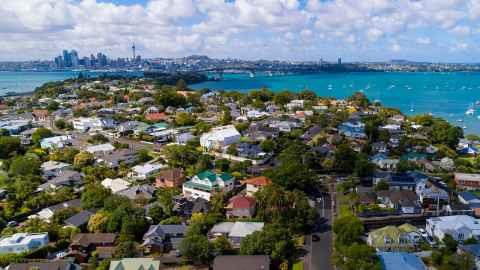How the pandemic altered Auckland’s rental market
28 April 2023
The pandemic accelerated the work-from-home trend, and a recent study explores the effects this shift has had on Auckland’s urban rental structure.

Following the advent of Covid-19 and the resulting shift towards working from home, rents in Auckland’s lower-density, city-fringe suburbs increased more than those in the city centre, according to a study published in the International Journal of Housing Markets and Analysis.
University of Auckland Business School academics William Cheung and Edward Yiu, together with research scientist Daniel Wong, used rental listings data in 242 Auckland suburbs from January 2013 to December 2021, as well as micro-level household data from Statistics New Zealand to understand this trend.
They applied a rental gradient analysis to compare rental prices pre-and post-Covid-19 and found that the difference in rental prices between the city centre and suburbs further out becomes much less pronounced after 2021.
Because many businesses introduced more flexible working arrangements following the onset of Covid-19, suburbs further away from the office likely became more attractive places to live, says Cheung, and in turn, this pushed rent prices up.
“We found that rents were increasing more in lower-density suburbs and that the city experienced rental gradient flattening, meaning the difference in rental prices between the city centre and suburbs further out became less pronounced post-pandemic."

“Typically, the city centre is supposed to be the most expensive part of the city, and as you move out towards the city fringe, and further, rents usually decrease. But because many people had the freedom to work from home, more people decided to live in the city fringe areas. And because they did that, it pushed the prices up.”
Cheung says this suggests that working from home is reshaping the urban rental structure by creating more demand for rental properties in city fringe suburbs.
“The early rental gradient and the micro-level household data analysis confirm a shift towards working from home, and I think it will likely be a long-term shift. Instead of resisting the change, organisations should improve their remote work policies and capabilities.”
The researchers suggest that this shift in the rental market may have implications for urban planning and policy and recommend that policymakers consider the changing needs and preferences of people who work from home when making decisions about housing and transportation.
Overall, the study, included in a special issue Yiu and Cheung edited for the International Journal of Housing Markets and Analysis, provides early evidence that work from home is reshaping the urban rental structure.
As more people continue to work from home, Cheung says it will be interesting to see what impact this shift will have on the rental market and urban planning more broadly in future and in other cities.
Yiu, C. Y. E., Cheung, K. S., & Wong, D. (2023). Does work-from-home reshape the urban rental structure? Early evidence from a rental gradient analysis in Auckland. International Journal of Housing Markets and Analysis.
Media contact:
Sophie Boladeras, media adviser
M: 022 4600 388
E: sophie.boladeras@auckland.ac.nz